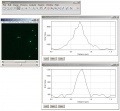Chromatic aberration measurement and correction
From BioDIP
(Difference between revisions)
(→images) |
|||
| Line 1: | Line 1: | ||
| + | One main issue in multi-color imaging is the precise overlay of the single channels. This becomes especially important for pixel-precise colocalization analysis. Therefore this test does make most sense for high resolution objectives. Several points are to consider for a perfect overlay of colors: | ||
| + | * coupling of the lasers: often "UV" and "VIS" lines have separate couplings due to the necessity for different fibers; the coupling precision influences the registration of "UV" and "VIS" lines | ||
| + | * collimator lenses: various systems allow to further influence the overlay of "UV" and "VIS" via collimator lenses | ||
| + | * objective corrections: the level of correction for chromatic abberations varies between objectives | ||
| + | * objective damages: the correction of objectives can be ruined by objective damages | ||
| + | * pinhole registration: on systems with multiple pinholes such as the Zeiss LSM 510, one might run into the additional trouble of pinhole alignment; if the pinholes are not well registered to each other, signals get displaced | ||
| + | Now it's clear that several combinations of acquisition settings should be tested. A good start is a stack of 3 colors (RGB, i.e. EX 405, 488, 561 nm) with open pinhole(s). | ||
| + | |||
*overlay UV/V and VIS (confocal systems with separate UV/V laser coupling) | *overlay UV/V and VIS (confocal systems with separate UV/V laser coupling) | ||
**purpose: check the coupling precision of the UV/V laser | **purpose: check the coupling precision of the UV/V laser | ||
Revision as of 10:59, 1 October 2009
One main issue in multi-color imaging is the precise overlay of the single channels. This becomes especially important for pixel-precise colocalization analysis. Therefore this test does make most sense for high resolution objectives. Several points are to consider for a perfect overlay of colors:
- coupling of the lasers: often "UV" and "VIS" lines have separate couplings due to the necessity for different fibers; the coupling precision influences the registration of "UV" and "VIS" lines
- collimator lenses: various systems allow to further influence the overlay of "UV" and "VIS" via collimator lenses
- objective corrections: the level of correction for chromatic abberations varies between objectives
- objective damages: the correction of objectives can be ruined by objective damages
- pinhole registration: on systems with multiple pinholes such as the Zeiss LSM 510, one might run into the additional trouble of pinhole alignment; if the pinholes are not well registered to each other, signals get displaced
Now it's clear that several combinations of acquisition settings should be tested. A good start is a stack of 3 colors (RGB, i.e. EX 405, 488, 561 nm) with open pinhole(s).
- overlay UV/V and VIS (confocal systems with separate UV/V laser coupling)
- purpose: check the coupling precision of the UV/V laser
- requirements: 0.2/0.5µm fluorescent beads sample
- work flow: open pinhole(s), use high resolution apochromatic lens (NA 1.2 or above), acquire two images (UV/V plus VIS channel) with good sampling (pixel size ~100nm)
